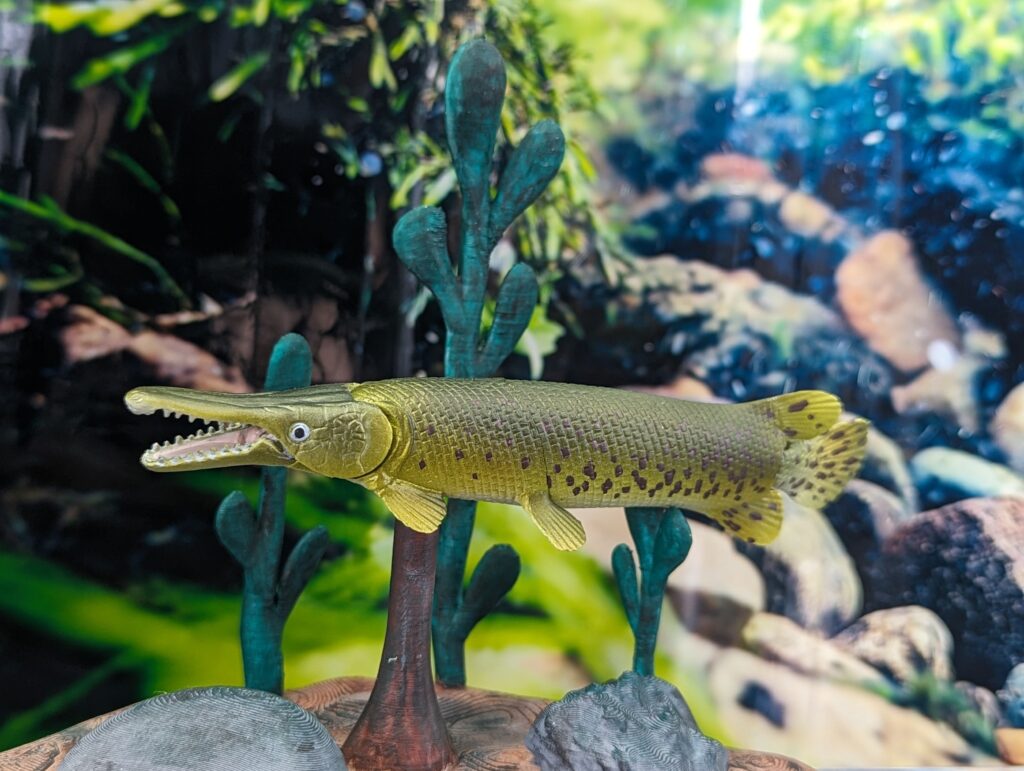
This will be a discussion of the fourth and last figure from this Takara Tomy set featuring some unique fish species that are visually or culturally striking. Based on my best attempt to translate the papers it appears to be called World Fishing Monster Fish, but take that with a grain of salt. Like the first post about the variants of the goliath tigerfish this species is notable through appearances on shows like River Monsters and, yes, Monster Fish, as well as a whole lot of cultural notoriety that is finally getting some proper respect. Not only a relatively well-known primitive fish (a true ‘living fossil’ based on recent evolutionary rates research no less), but also recently designated the state fish of Arkansas, the alligator gar, Atractosteus spatula.

As far as large and notable freshwater fish go, alligator gar are probably among the most familiar. They are notable for their variably long, fusiform bodies, covered in hard and bony ganoid scales (similar to but not of the same composition as those of bichirs). They have long bony snouts lined with sharp, fish-catching teeth–a notable variation within gars is the number of rows of teeth in the upper jaw. The genus that contains the alligator gar, Atractosteus, have two rows of teeth–there is a row of longer palatine teeth; the other genus, Lepisosteus, only has one row in the upper jaw. Like many ‘primitive’ fish their skeletons are cartilaginous. The swim bladders of gars are modified as functional lungs, allowing them to live in oxygen-free environments. This is an important adaptation since gar as a group are primarily freshwater, preferring highly variable shallower weedy areas of rivers, lakes and bayous, although some species wander into brackish and today’s subject will even move into marine environments.
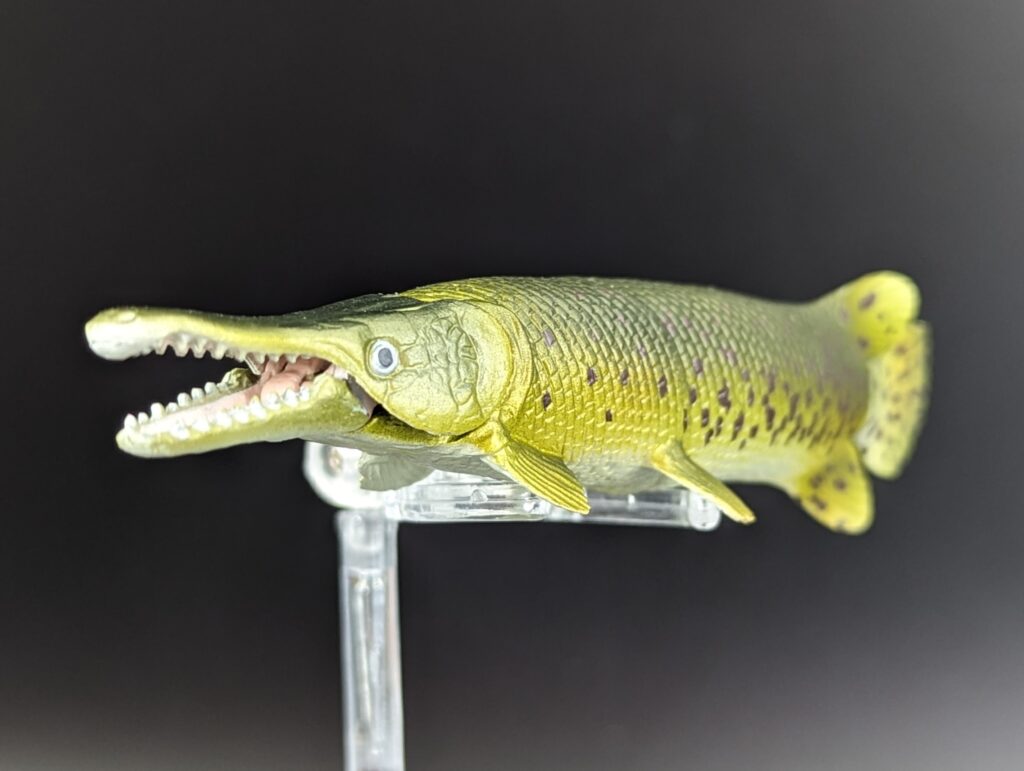
As mentioned, they are all active predators, preying primarily on smaller animals…mostly fish and crustaceans as adults, although the young start with invertebrates. One thing they can’t really do…despite the alligator-like snout, their teeth don’t really allow taking bites out of large animals. They can still bite either in defense or by accident, but generally wouldn’t be very interested in attacking people as food (in spite of rumors and urban myths). But they look scary…and between the thought that people were attacked (more likely sympatric crocodilians), and that preferred local fish (eg. bass, catfish, salmonids) were being ‘overeaten’ by these predators, many conservation organizations considered them ‘trash’ fish and set about trying to exterminate them with extreme prejudice.

It’s a testament to their survivability that the seven species survived this…but they were heavily impacted. In recent years, the importance of gars (and other non-game fish like the related bowfin) is starting to be recognized. Even their value as a sport fish for anglers–especially giants like alligator gar; and it turns out they are also good-eating if that’s you thing (but never eat the roe–it’s very toxic). Attitudes are slow to change though…so there are still some perceptions that gar need to be eradicated (look up what some bowfishing tournaments look like to feel extra depressed) which can still have a great impact on these slow-breeding fish. Many species were extirpated from much of their range, and the alligator gar is no different–originally found in a wide part of the eastern US and northeast Mexico, they are more restricted to the southern portions of their range; they are also much less common in those areas. There have been reintroduction efforts in some areas at least–and they have also been found as invasive fish in parts of Asia and Europe! Despite these issues, the IUCN lists the alligator gar as Least Concern, although they may be variously protected where they occur.
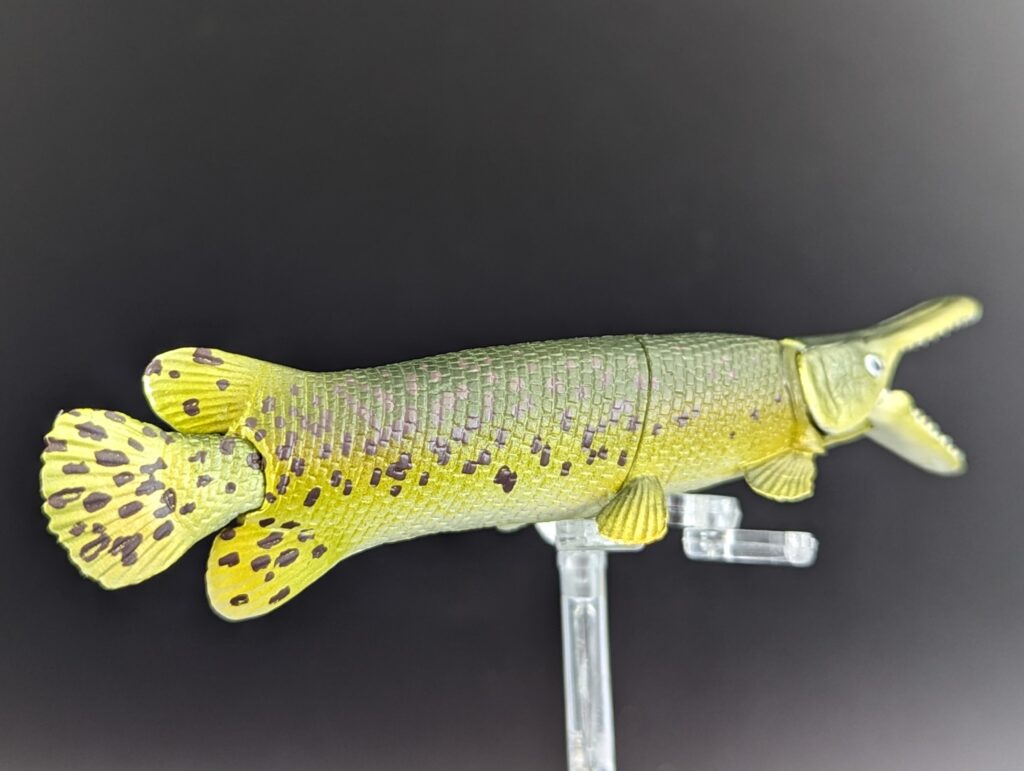
Gar overall are large fish, but alligator gar are right up there in the roster of truly giant freshwater fish, certainly one of the largest in North America. Currently large specimens are about 1.8 metres (6 feet) long and 45kg (100lbs) but historic records indicate individuals over 3 metres (10 feet) and 159 kg (350lbs). And there are still giants out there, with individuals of 7 – 8 metres sometimes caught; it is possible that these fish could be 50-70 years old, possibly even older. It’s always amazing to see photos of these amazing giants…and also a little depressing if they’ve been killed; as with many fish, the large individuals are the ones that contribute most to breeding and maintaining the species.

So, with all of that introduction to gars out of the way (apparently, this is their first time on the blog) let’s look at one of the newer takes on the alligator gar. First thing to be aware of, being part of the Takara TOMY series, it is articulated and in multiple pieces. In the case of this figure, there are five pieces–front of the body including upper jaw, head to the pelvic fins; lower jaw; back half of the body from behind the pelvic fins to the base of the tail/unpaired fins; and the tail. To be clear, the primary split in the body is down the middle of the body, which is unfortunate. The line of the cut is diagonal along the line of the scales, but is still clearly visible.

There are two articulations. The tail bends at the peduncle of course (this is pretty standard with the Takara fish) and the jaw opens and closes. This latter feature is probably the most exciting aspect of the feature–as with the tigerfish, the jaw does not open with a simple drop or rise of one jaw, instead the head moves forward while both jaws open at once, giving the fish a wide, and natural, gape. It’s always nice to see articulation used in a way that actually reflects the animal realistically.

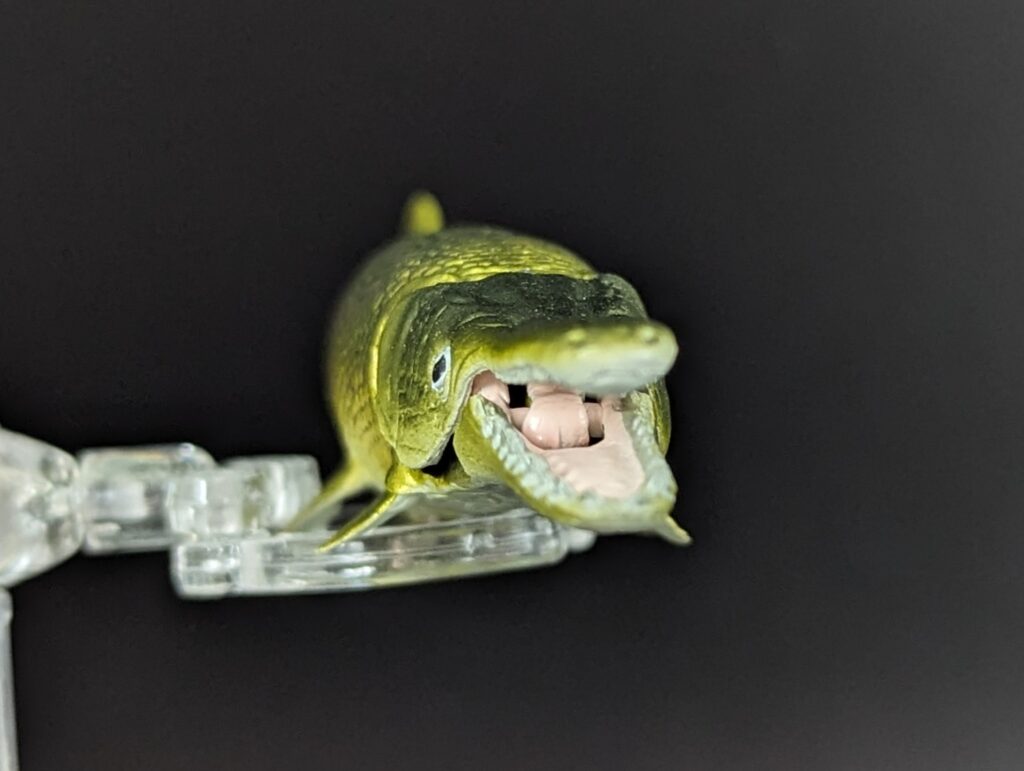
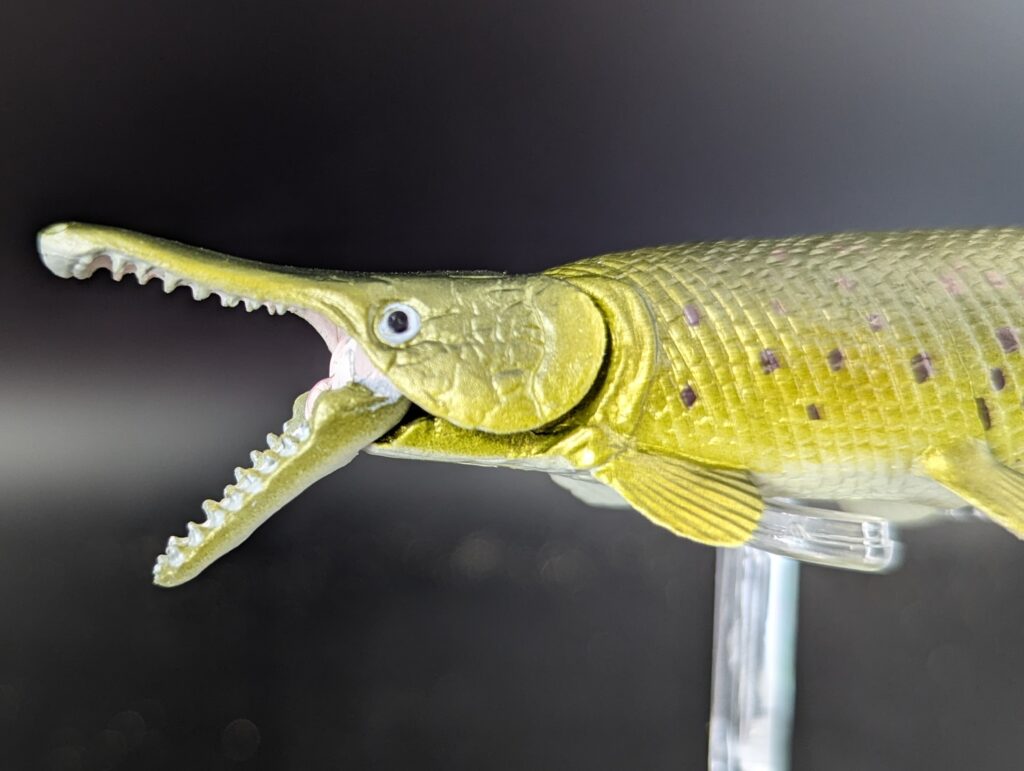

In terms of appearance, the figure is very well done. The body is just under 14cm TL, so the scale you get will vary. Assuming a massive 3 metre individual from alligator gar heyday–it would be about 1:22. A modern maximum size 2 metre behemoth–we’re looking at about 1:14. But for a more reasonable modern adult animal (and this is an adult), maybe around 1.5 metres long, it would be around 1:11. So it really depends on what you want, or what you’re trying to represent. The overall shape of the body is a stocky fusiform fish, pretty much uniform from the opercula to the base of the tail. The fins are clearly sculpted from the body with distinct fin rays marked out. The fins are positioned well and accurately. The body narrows laterally from the mid-point until the posterior end where the tail piece attaches; the shape continues to narrow to a point along the tail fin. The tail fin is rounded, and appropriately heterocercal; as is seen in gars, the upper margin of the tail extends a little further posteriorly, while the lower edge is more rounded.
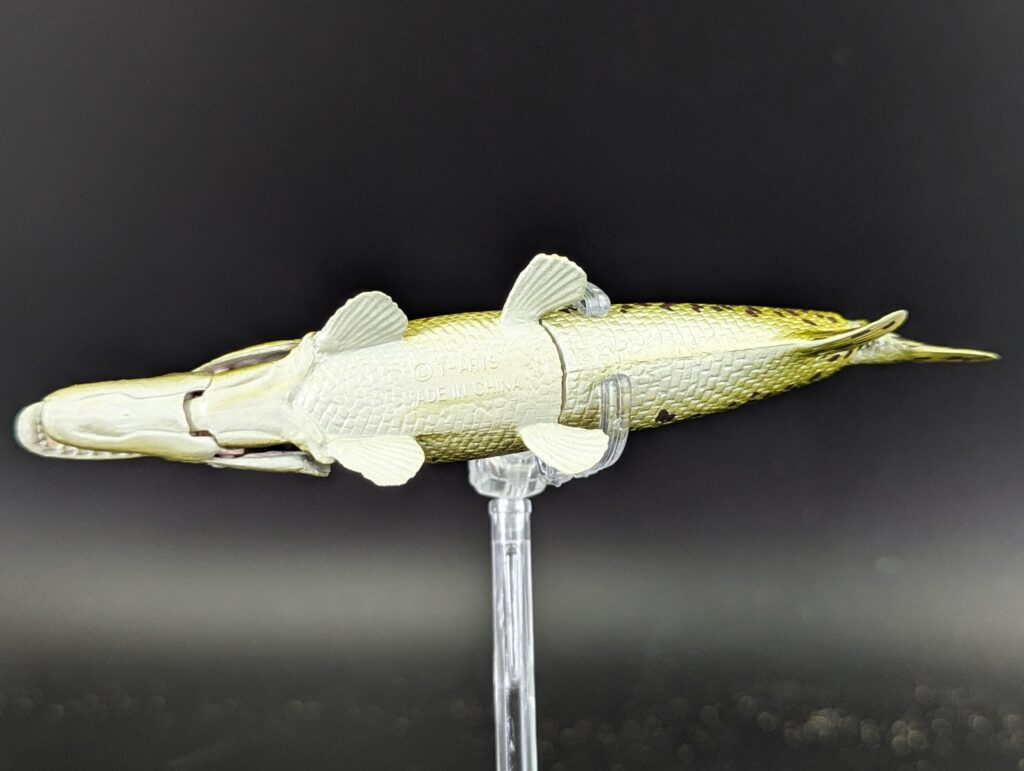
The fish definitively indicates an adult based on the colouration and the head shape. To speak of head shape first, the figure captures the heavy, broad skull seen in an alligator gar. The sculpt shows the distinct skull bones on the top of the head and bottom of the lower jaw (this very bony snout is why hooking a gar on rod and reel is such a challenge!). The cheeks have the incised patterns normally seen on the fish face, and the opercula are well sculpted with the back of the head moving over the gill plate. The eye is large and bright, painted gold with a black pupil. The upper jaw extends past the lower jaw with a large bulge at the tip, with nostrils indented at the top. This broad head and especially the bulge at the tip is one indicator that we are seeing an adult individual. There is a slight curve along the lower edge of the upper jaw, giving an uneven line between the jaws (not that they come together easily on the figure). Importantly, as mentioned before–looking inside the mouth show two rows of teeth in the upper jaw, as a member of the genus Atractosteus should have. The teeth are individually picked out, although not quite as thin and needle-like as the real animal, and especially on the lower jaw, there should be more variability in the tooth heights along the margin. But overall it’s an okay representation.

For colouration, the overall colour is a dark olive, typically seen on the largest adults. This colour covers most of the dorsal and lateral surfaces of the head and body, blending at the midway down the sides to be more greenish than finally shading to off-white on the belly and jaw underside. At the mid-line on the sides there are small black spots; a few are present between the pectoral and pelvic fins, and the number of spots increases greatly between the pelvic fins and caudal peduncle. These spots also extend onto the anal, dorsal, and tail fin. The top of the paired fins are also the dark olive throughout, while the the dorsal and anal fins are dark at their base, fading to a lighter green. The base of the tail (the separate piece) also starts at dark olive on the peduncle, then fades to white, then light green along the posterior margin. The entire fish has a slight sheen to it, not exactly metallic but more like a satin finish.

In short, I would very much recommend this figure for a fish collection. The size gives it a more impressive presence that would suit collections of modern North American animals (and could be a large stand-in for congeneric species from the Cretaceous and Cenozoic). It especially stands out as it is presented with an open mouth (I have several and only one other has this, the Hellbender Museum model, which are quite a bit less accessible). Really, the whole series is pretty great (the tigerfish are standouts, the eel is at least very good). I am always a fan of these kinds of unusual freshwater fish, and I think everyone should try to encourage them to be made–especially if they are to this level of quality in design.

Disclaimer: links to Ebay and Amazon on the AnimalToyBlog are affiliate links, so we make a small commission if you use them. Thanks for supporting us!



